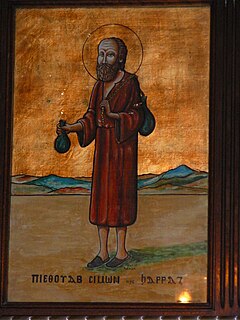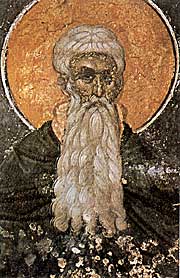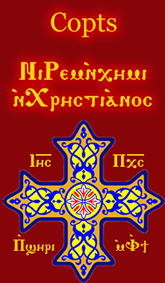This article needs additional citations for verification .(December 2012) (Learn how and when to remove this template message) |
Saint Isaac of Dafra is an Egyptian martyr and saint.
This article needs additional citations for verification .(December 2012) (Learn how and when to remove this template message) |
Saint Isaac of Dafra is an Egyptian martyr and saint.
Isaac was born in Dafra, near the modern city of Tanta. According to Coptic manuscripts, an angel encouraged him to travel to the town of Towa, near Beba in the Bani Suwayf Governorate, to profess that he is of Christian faith in front of the governor and to receive martyrdom. [1]
The governor had Isaac sent to his house under guard for torture, but while en route a blind man begged Isaac for help, whom he blessed and immediately the blind man could see. The guard moved Isaac onto the governors house, where upon arrival the guard admitted that he too now believed in Christ. The guard would be executed.
After being severely tortured Isaac was then sent to Oxyrhynchus for further torture and, eventually, execution. While being transported by boat Isaac begged a man with a blind and closed eye for water. Upon receiving the water he threw a few drops upon the blind man's closed eye, after which he could see again. [1]
After his arrival and further torture it is said that the inhabitants of the city of Behnesa came and begged for Isaac to be killed swiftly or released as many auspicious events had happened around his arrival. He was beheaded quickly. Some Christians returned Isaac's body to his town of Dafra, where a church was later built after him. Many miracles that happened around the church were attributed to him. [1]
The feast day of Saint Isaac of Defra is on 6 Pashons [2] in and around the month of May.

Anthony or Anthony the Great, was a Christian monk from Egypt, revered since his death as a saint. He is distinguished from other saints named Anthony such as Anthony of Padua, by various epithets of his own: Saint Anthony, Anthony of Egypt, Anthony the Abbot,Anthony of the Desert,Anthony the Anchorite,Anthony the Hermit, and Anthony of Thebes. For his importance among the Desert Fathers and to all later Christian monasticism, he is also known as the Father of All Monks. His feast day is celebrated on 17 January among the Orthodox and Catholic churches and on Tobi 22 in the Coptic calendar.

Pachomius, also known as Saint Pachomius the Great, is generally recognized as the founder of Christian cenobitic monasticism. Coptic churches celebrate his feast day on 9 May, and Eastern Orthodox and Roman Catholic churches mark his feast on 15 May or 28 May. In the Lutheran Church, he is remembered as a renewer of the church, along with his contemporary, Anthony of Egypt on January 17.

This article uses dates and years written in the Coptic calendar, using the A.M. calendar era, in addition to the Gregorian calendar, using the A.D. calendar era.

Simon the Tanner, also known as Saint Simon the Shoemaker is the Coptic Orthodox saint associated with the story of the moving the Mokattam Mountain in Cairo, Egypt, during the rule of the Muslim Fatimid Caliph al-Muizz Lideenillah (953–975) while Abraham the Syrian was the Pope of the Coptic Orthodox Church of Alexandria.
Pope John V of Alexandria, 72nd Pope of Alexandria and Patriarch of the See of St. Mark. He was initially a monk in the Monastery of Saint John the Dwarf in Scetes. He was enthroned as a Pope of Alexandria on the second day of Pi Kogi Enavot, 863 A.M..
Pope Mark VII of Alexandria , 106th Pope of Alexandria & Patriarch of the See of St. Mark. Pope Mark VII was born in the city of Klosna, in the district of El Bahnasa, and his lay name was Simeon. He joined the Monastery of Saint Anthony at a young age, then moved to the Monastery of Saint Paul the Anchorite, where he became a monk and was ordained a priest. When Pope John XVII departed, he was chosen to succeed him. Pope Mark VII was ordained Pope and Patriarch of Alexandria on Sunday, 24 Pashons, 1461 A.M. on the day of the feast of the entry of Christ to Egypt.

Saint Arsenius the Deacon, sometimes known as Arsenius of Scetis and Turah, Arsenius the Roman or Arsenius the Great, was a Roman imperial tutor who became an anchorite in Egypt, one of the most highly regarded of the Desert Fathers, whose teachings were greatly influential on the development of asceticism and the contemplative life.

Marina, distinguished as Marina the Monk and also known as Marinos, Pelagia and Mary of Alexandria, was a Christian saint from part of Asian Byzantium, variously said to be Syria or Lebanon. Details of the saint's life vary.
Master Malati or Moallem Malati is a Coptic Orthodox martyr and saint.
Otimus is a 3rd-century Egyptian martyr and saint. Otimus was born in Fowwa, and later became its priest. After some time, he moved to the mountain of Ansena. When Emperor Diocletian incited his persecution against the Christians, Arianus the governor of Ansena called for Otimus and ordered him to worship the idols. When Otimus refused, Arianus tortured him and eventually ordered him to be burned on 3 Pashons. The relics of Otimus are believed to be in the city of Kalabsha.
Saint John of Senhout is an Egyptian saint from the 4th century AD.
Saint Epimachus of Pelusium was an Egyptian martyr.
Abāmūn of Tarnūt is a saint and was a martyr of the fourth-century Coptic Church. He is known only from his name being mentioned in the Synaxarion of Mikhail of Atrib (c.1240). His feast day is 3 August.

Saint Moura, also known as Mart Moura, is a Christian martyr of the third century and is honored in Egypt and the Middle East. Her feast is celebrated on 3 May and on 25 September, 5 Hathor and 8 Pashons in the Coptic church. Several churches are dedicated to her, especially in northern Lebanon, as well as a monastery in Ehden.
Saint Colluthus is a Coptic saint and martyr of the 3rd century AD said to be from Antinoöpolis.

Coptic history is part of history of Egypt that begins with the introduction of Christianity in Egypt in the 1st century AD during the Roman period, and covers the history of the Copts to the present day. Many of the historic items related to Coptic Christianity are on display in many museums around the world and a large number is in the Coptic Museum in Coptic Cairo.

Mercurius was a Christian saint and a martyr. He was born in the city of Eskentos in Cappadocia, in Eastern Asia Minor.

Abanoub or Abanoub Al-Nahisy, is a 4th-century Christian saint and martyr from Egypt. His name means Father of Gold in Coptic. He was born in Nehisa in the Nile Delta to Christian parents. Abanoub was 12 years old when he was killed and beheaded, after being tortured for refusing to leave Christianity. His feast day is July 31. His relics are preserved in St.Virgin Mary and St.Abanoub Churches in Sebennytos, Egypt. His title is often The Child Martyr.

Abaskhiron the Soldier or Eskhayron the Soldier is an Egyptian martyr and saint. The name "Abaskhyron" is derived from two words, "Abba" which means father, is given to him out of respect. The second part of the name, "skhyron", sometimes "eshseros", "eskaros", means the strong.
Saint Wanas was a Coptic child martyr born to poor parents from Thebes, Egypt. He is venerated as the patron saint of lost things.